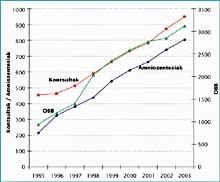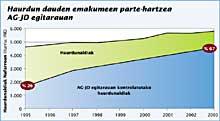Significant increase in prenatal diagnosis

In order to detect possible abnormalities of the fetus, in Navarra the Program of Genetic Counselling and Prenatal Diagnosis (AG-JD) was created in 1995. The main objective of the program is to reduce the number of people with disabilities due to congenital anomalies and genetic diseases, providing couples with objective and precise indications, making a prenatal diagnosis in high-risk pregnancies and creating a Registry of Congenital Anomalies and Hereditary Diseases, which allows a continuous evaluation of DA-J.
Prenatal diagnosis
In order to conduct a prenatal genetic consultation, it is necessary to meet a number of requirements, such as the mother being thirty-five years or older. It is known that certain genetic diseases are directly related to the mother's age, such as Down syndrome, women who have a much greater risk than young women of having a child with Down syndrome. On the other hand, if another child of the couple has suffered abnormalities, if there is any hereditary disease in the family or if the mother has taken any medication that may harm the fetus, then the pregnancy will be considered high-risk.
In these cases, the couple has the possibility of attending the DA-AP consultation. In the consultation, after analyzing the family's medical history and the results of other tests, if appropriate, the doctor offers the possibility of making a genetic diagnosis of the fetus. This diagnosis can detect chromosomal defects of the fetus.
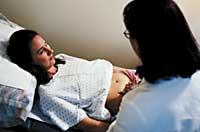
Women under the age of thirty-five also have two options: Biochemical Blood Observation (OBB) and fetal ultrasound. The risk of certain irregularities related to OVB chromosomes, such as Down syndrome and bifid spine, is calculated.
This includes the amount of alpha-fetoprotein (AFP) and chorionic gonadotropin (HGC) measured in maternal blood; the mother's age; and the measurement of the fetal brain fold. In fact, when AFP descends and HGC increases, the fetus is at higher risk for Down syndrome. On the other hand, the low level of HGC is related to Edwards syndrome and that of AFP with the bifid spine. The crease of the fetus's neck is measured by ultrasound of the fetus; if it is larger than 3 mm, the fetus is more likely to suffer from a problem, such as Down syndrome, Turner syndrome, or heart disease.
When an abnormality is observed in the CBO or ultrasound, the mother is advised to go to the office if desired. They allow you to perform a genetic diagnosis of the fetus to check for irregularities observed in previous tests.
The main reason for attending this consultation is the age of the mother. In Navarra, for example, more than 6,000 consultations were held between 1995 and 2003, of which more than 4,000 have been due to the age of their mother. But positive UFOs and abnormalities detected in ultrasound scans are also important, as they are 20% of the visits.
Biochemical Blood Observation has many advantages. Most importantly, it is done in maternal blood and does not affect the fetus, so the risk of abortion is avoided. That is why more and more women choose this test. For example, 24% of pregnant women in Navarra in 1995 did so and 68% in 2003. But it also has some disadvantages. The sensitivity of the test is 63%, which means that in 37% of cases, although the result is negative, the child can be born with Down syndrome.
This low degree of sensitivity is the main error of prenatal diagnosis, and in women under 35 years of age or in pregnancies not subject to special risks no tests are performed in public health services. To overcome the problem other biochemical tests are being studied and improvements are expected over time.
Genetic diagnosis of the fetus
Another test to detect chromosomal abnormalities is the Fetal Genetic Diagnosis (FDG). The main objective of this test is to define the chromosome or cariotype figure of the fetus. In some cases, in addition to chromosomes, some special genes are studied.

The karyotype of ordinary people are 46XX (women) and 46XY (men). The number indicates the number of chromosomes and the letters the nature of the pair of chromosomes that define sex. And when there are changes in the number of chromosomes or the structure of these chromosomes, genetic diseases or abnormalities can occur. For example, people with Down syndrome have three copies of chromosome 21 instead of two, so the karyotype of Down syndrome is ‘47 XX (or XY) + 21’.
Unlike CBO, the genetic diagnosis of the fetus is performed directly with this test, making it error-free. That is their main advantage. But in order to perform this test, it is necessary to take an amniotic fluid that takes care of the fetus (amniocentesis) or another part of the structure around the fetus, which can pose a risk to the fetus. The level of risk depends on many factors: age of the mother, experience of the person performing the technique, etc.
In this area there has been a significant increase in recent years. On the one hand, more and more ports under 35 years are performing OVB, so there are more positive results and therefore more FDG. And, on the other hand, since children are later than before, more and more women are able to test proportionately: of all species before 16% were older than 35 years and now are more than 25%. In addition, there has also been a significant change in the decision to make the FDG. When the program began, in high-risk pregnancies only half of women claimed to do so and today almost all opt for the test.
With FDG, in addition to Down syndrome, there are many other chromosomal irregularities such as irregularities in sexual chromosomes. In the period 1995-2003, six out of 1,000 karyotype have some type irregularity: 45X, 47XXY, 47XXX or 47XYY. Irregularities in sex chromosomes do not always cause damage. Many people with this type of karyotype live for several years without knowing anything, but they may also have some drawbacks, such as mental retardation and sterility.
Edwards syndrome and Patau syndrome are also very numerous. In the trisomies there is a chromosome, with three copies instead of two (Chromosome 21 in Down syndrome, Edwards syndrome 18º and Patau syndrome 13º).
The higher the tripled chromosome, the more important the child's abnormalities are and therefore the more likely to die. Therefore, those affected by Patau syndrome are born and die quickly, and those born with Edwards syndrome rarely last a year. In the case of Down syndrome, on the contrary, chromosome 21 is very small and can live for many years.
Registration in progress
In orderto analyze all these congenital anomalies and study the epidemiology of hereditary diseases, a project was launched in Navarra in June 2003: Registry of Congenital Anomalies and Hereditary Diseases of Navarra (RICIA). This registry is a valuable resource that will allow the continuous evaluation of these diseases.
In the registry are collected the newborns of Navarra that have some congenital anomaly and the unborn alive. To date, 823 cases have been collected. This represents a prevalence of 1.36%, although it is known that the prevalence of congenital anomalies is higher, around 2-5%. Therefore, there will still be much work to collect all the cases of Navarre. This will be the main objective of the project in the coming years.
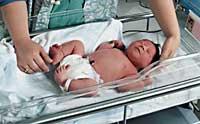
But with what has been collected so far, many conclusions can be drawn. For example, when are congenital abnormalities and hereditary diseases detected? Most, 37%, are seen at birth, but 34% are detected before birth. The rest is detected throughout the child's life. Before the year 18% and after the year 11%.
The main objective of the AG-JD program is to expand the second number, that is, detect the greatest number of anomalies before birth to reduce their adverse effects on the couple and society in general.
As an example, we will mention the case of Down syndrome. Before the start of the AG-JD program, in the period 1986-1994, 67 children with Down syndrome were born in Navarre, approximately 15 out of 10,000 births. After the program began, 57 (12 out of 10,000 births) were born in 1995-2003.
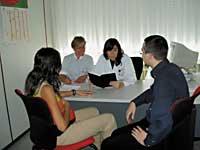
The number of children born year after year with Down syndrome may increase or decrease, but since prenatal diagnosis the trend is descending. In addition, among those born with Down syndrome, around 40% of the cases the mother was over 35 years old, so if you so desired had at your disposal the possibility of prenatal diagnosis.
In this sense, it must be said that the demand for prenatal diagnoses is increasing, very quickly. The tendency to delay maternal age and change of mentality of pregnant women, who are increasingly choosing genetic diagnosis
Bibliography:
- 1888.
- How are we in health 2,000?
• Annals of the Navarre Health System. 99-103. - Correa-Villaseñor A. et al.
The Metropolitan Atlanta Congenital Defects Program: 35 Years of Birth Defects Surveillance at the Centers for Disease Control and Prevention. Birth Defects Research (Part A) 67:617-624 (2003).



